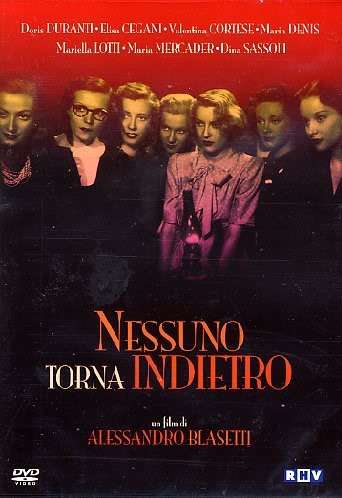
Late fascist chickflick or early lib melo – hard to tell. Early production title was Vagine di ferro.Read More »

Late fascist chickflick or early lib melo – hard to tell. Early production title was Vagine di ferro.Read More »
Alessandro Manzoni’s book I Promessi Sposi from 1823 seems to be one of the best kept secrets of the whole Italian literature. While by many considered to be the greatest novel ever written in the Italian language, it doesn’t seem to have a particularly strong reputation abroad. I first heard about it from an Italian friend during a long night of Totò films and beer some months ago, but when doing some googling after watching Camerini’s film during a train trip yesterday, I realized that I actually have a Norwegian translation myself, bought some years back when I spent most of my time going to book sales in Oslo and filling up my parents’ attic with everything I came across.Read More »
Like Piccolo mondo antico, Malombra is a film set in a grandiose, but a bit crowded aristocratic house, which is itself squashed between the beautiful, but deadly see, and the stolid, un-romantic mountains. A claustrophobic space with no escapes, a space of directionless hauntings and self-induced psychosis. Also, of course, a space of late, musty fascism. The reality of the second world war and the twilight of the Mussollini era is never directly alluded to, but it seems to penetrate all walls, clothes, the flesh itself.Read More »
Synopsis:
Vittorio De Sica, heir to a large sum of money and owner of a newspaper vending stall, makes enough money out of his business to take a vacation at a fashionable resort. He is given a cruise ticket by an aristocrat who is an old school friend, and is mistaken for the aristocrat when he uses a camera that has his friends name on it. Assia Noris plays a maid who falls in love with him because of who he is and not who others think he is.
Remade as Il Conte Max with Alberto Sordi in the De Sica role and the latter as the uncle.Read More »
SYNOPSIS
Respectable bourgeois wife (Renee Saint-Cyr) turns out a mysterious bunch of scarlet roses and yields to temptation of adultery. Vittorio de Sica’s director debut (with supervision by Giuseppe Amato); light but already a little bitter comedy based on skillful Aldo de Benedetti’s stage hit. Naturally, superstar De Sica playing the main role himself – and is on the top of his charm here.
Sadly, there is only Spanish theatrical release (from that time), with Spanish dubbing and titles.Read More »
Romance between a saleswoman and a driver of the Department Store. Charged with a petty theft, she is blackmailed by the chief of staff to enjoy her favors, but the driver, after doubting her, discovers the real culprits.Read More »

Synopsis:
Also known as Three-Cornered Hat, this Italian comedy is based on a Spanish folk tale, which had previously been adapted as a ballet by Manuel de Filla. Director Mario Camerini and his team of screenwriters have refashioned the material as a vehicle for the popular De Filipo brothers, Peppino and Eduardo. The story is a mistaken-identity affair, predicated on the fact that a pompous governor is the exact look-alike of a poor miller. Much of the fun is derived from the efforts to pass off the miller’s homely wife as the governor’s gorgeous spouse. Described by one Mario Camerini devotee as “pretty, noisy and accomplished,” ‘Il Cappell a Tre Punte’ was filmed in 1934, and released in the U.S. two years later.Read More »
Quote:
Scalera had obtained backing for a series of animal shorts and needed someone to make them. Roberto plunged in enthusiastically. He arrived at Ladispoli with animals of all sorts distributed among pockets and cages and started sixteen documentaries, no less, all at once. A slew of titles were annouced. La foresta silenziosa (“The quiet forest”), Primavera (“Spring”), Re Travicello, and La merca; and perhaps ll brutto idraulico (“The ugly plumber”). Fellini recalls finding Roberto at Scalera kneeling under small reflectors. “Inside a small enclosure made of nets and rope were a turtle, two mice, and three or four roaches. He was shooting a documentary about insects [La vispa Teresa?], doing one frame a day, very complex and laborious, with great patience.”
“He kept shooting for months,” Fellini adds, probably with his customary exaggeration. For in fact Roberto’s enthusiasm flagged quickly.Read More »
PLOT SYNOPSIS:
Desperate because abandoned by his lover (V. Alexandrescu), orchestra conductor hesitates: to kill himself, or kill her? He simply shoots the portrait of the lover and returns to conducting, helped in his “resurrection”, by a cute girl (L. Franca), who restores his will to live.
Second film by Blasetti, after the silent “Sun” (1929), and the only one for which he signs the script himself. Produced by Cines, it is the first Italian sound film but, deemed not commercial enough, was released after La canzone dell’amore (1930) by Righelli.
It is interesting at stylistic level, for the ambitious mixage of dialogs, music (Amedeo Escobar) and noises in parallel with experimental visual inventions.Read More »